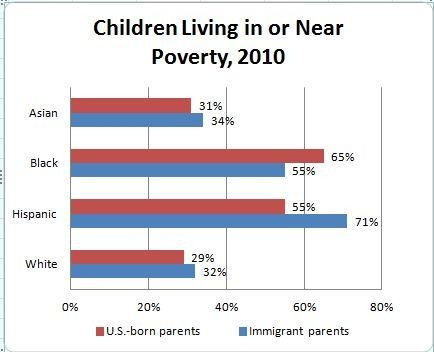
As the political struggle regarding the DREAM Act continues, studies emerge indicating that children of Hispanic immigrants are struggling even more when it comes to their education. A recent study by the Foundation for Child Development, written by Donald J. Hernandez, a sociology professor at Hunter College in New York City, found that race played a significant factor in the success of young children in school as well as immigration status.
The study indicated, however, that even U.S.-born children in certain demographics have a more difficult time in school than their children-of-immigrant counterparts. U.S.-native black children, for example, scored lower than black children of immigrants in 15 of the study's 19 indicators, including median income, graduations rates and employment.
"The groups that are worse off are Hispanic children of immigrant parents and black children of U.S. parents," said Donald J. Hernandez, the study's author and a sociology professor at Hunter College, at the City University of New York. "It is kind of surprising because we typically think of children of immigrants as not doing as well, and it's really a more nuanced picture that cuts over multiple indicators."
Hispanic children born of immigrant parents are more likely to live in poverty than any other group, with 71 percent of families having an average annual income of $33,396. On the other hand, the median income of white and Asian families regardless of immigration status is in the mid-to-high $70,000 on average. Those with incomes as low as a typical Hispanic immigrant family, a group in which the average income is less than twice the federal poverty level, also tend to move more often, which could pose a problem for stability in school.
In terms of academic proficiency, the study indicates that race plays a much larger factor than immigration status. While Hispanic and black children of immigrant families did fall below par in both reading and mathematics as compared to their U.S.-born counterparts, white and Asian children, regardless of immigration status, did not. On average, 83 percent of Hispanic children who speak another language at home were below proficient in reading by the 4th grade. The group broke even at 76 percent each in mathematics. This can be detrimental to success as children who are not up to par by 3rd grade are significantly more likely to drop out. Children of Asian immigrants, however, were split across the board with 51 percent of both U.S.-born parents and immigrant parents falling below proficiency in reading. A paltry 43 percent of Asian immigrant children lacked proficiency in math as compared to 35 percent for U.S.-born children.
As children grow older, the statistics change and worsen for Hispanic children. While U.S.-born black children are more likely to struggle in grade school than Hispanics, the graduation rate of black children is higher. Hispanic children have the lowest rate of graduation at 69 percent, with Asians having the highest at 89 percent. Hernandez concluded that the study indicates that race, more so than immigration status, hampers childhood success and pinned the problem on the way children are being educated in the U.S..
"One of the things that strikes me in both of these charts is the large percentage of students who are not 'proficient' in reading and math, across the board," Hernandez said. "It really shows we are not being successful in educating children in reading and math across the board; it's not about race, not about immigrant status."
© 2025 Latin Times. All rights reserved. Do not reproduce without permission.




